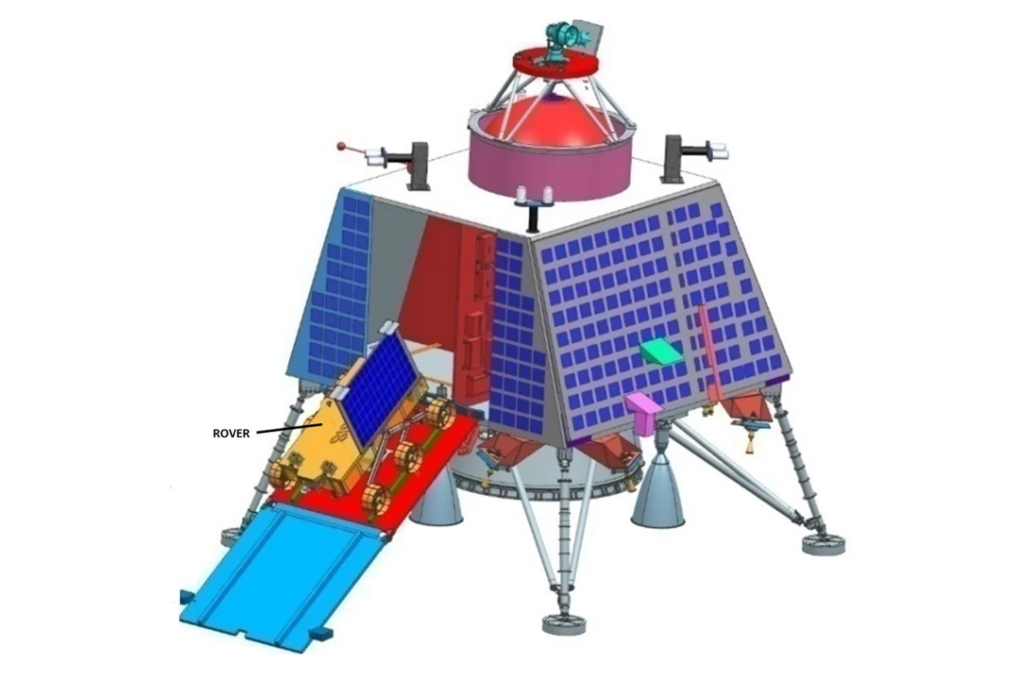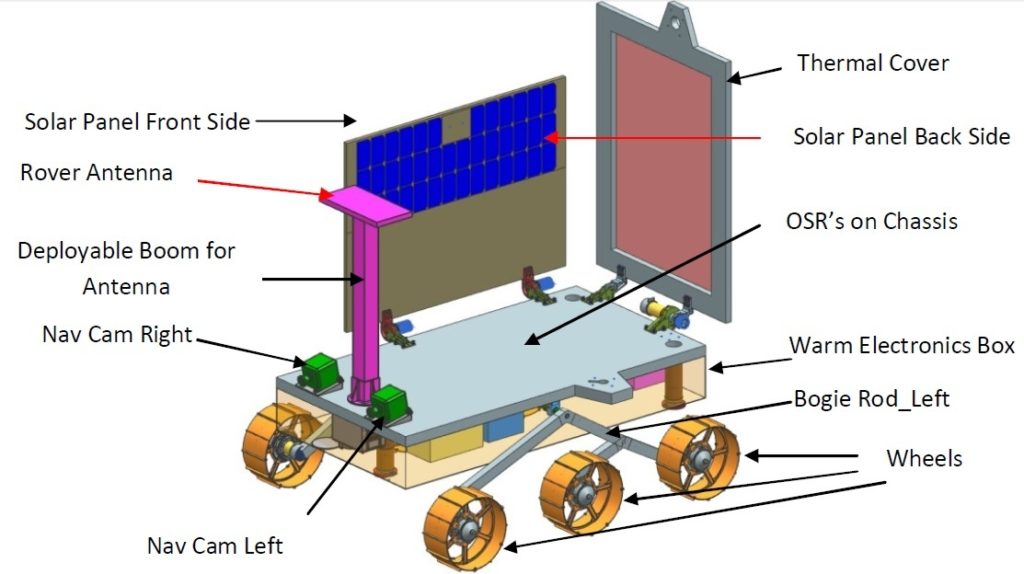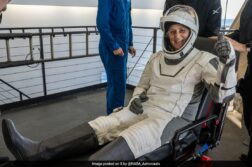India will become the fourth country in the world to achieve a soft landing on the moon after the USA, China and Russia. It is India’s second exploration mission – Chandrayaan 2 developed by the Indian Space Research Organisation (ISRO). It has launched on 22nd July 2019 at 2.43 PM from Satish Dhawan Space Center on Sriharikota Island and took place on ‘Geosynchronous Satellite Launch Vehicle’ (GSLV) Mark III of ISRO.

Chandrayaan 2 has now released on the air and will reach to the lunar land of the moon on 7th September 2019. It will take the correct 48 days and cover the distance of 3, 84, 000 km. It weighs 3,850 kg (8,490 lb).
This lunar spacecraft includes three modules along with the rocket called Orbiter, Lander (Vikram) and Rover (Pragyan). Here, we have mentioned the complete details of all these three modules.
Let’s know these 3 modules in-depth:
1. Orbiter- It’s the first module of Chandrayaan 2 which will orbit the moon at an altitude of 100 km. It includes five scientific components in which three are new and rest two are the improved version of first lunar spacecraft named Chandrayaan 2. The eight payloads are also sending with it which has different tasks:

- Prepare the map of the moon’s surface. It will be done to detect the existence and development of the moon.
- Detects the presence of magnesium, aluminium, silicon, calcium, titanium, iron and sodium.
- Measure the intensity of the solar radiation present in the sun’s rays.
- Click the high-resolution images of moon’s surface.
- Detect the presence of pit or rock on the surface for the smooth and soft landing
- Finding the presence of water and minerals on the southern pole of the moon.
- Detect water present in the form of ice in the pits of the polar region.
- Scanning the outer atmosphere of the Moon.
Important Facts of Orbiter
- Gross lift-off mass: 2,379 kg (5,245 lb)
- Propellant mass: 1,697 kg (3,741 lb)
- Dry mass: 682 kg (1,504 lb)
- 8 Payloads
2. Lander- This Lander is called Vikram which is named after Vikram Sarabhai. He was regarded as the father of Indian Space Programme. It will detach from the orbiter and then it will use its 800 N (180 lb) liquid main engines to descend on the lunar orbit of 30 km × 100 km (19 mi × 62 mi). After this, it will perform a comprehensive check on the whole board system before attempting a soft landing on the lunar surface. It also includes rover deployment and performs scientific activities for 15 days approx. The three payloads are also sending with it. Their job is to identify the electron density near the surface of the moon, the fluctuation in the temperature here movement (earthquake) below the surface, the speed and the intensity.

Important Facts of Lander
- Gross lift-off mass: 1,471 kg (3,243 lb)
- Propellant mass: 845 kg (1,863 lb)
- Dry mass: 626 kg (1,380 lb)
- 3 Payloads
3. Rover- The lunar spacecraft’s Rover is called ‘Pragyan’ which means wisdom. It’s placed inside the Lander and will come out from it at a speed of 1cm per second. It will take a complete 4 hours to come out. It will work on the moon for 1 day which equals to 14 earth days. It contains two payloads. The purpose behind them is to find out the presence of elements near the landing site and the fundamental structure of the rock and soil. Through the payload, the rover will collect these data and send it to the Lander which will send this data to ISRO.

Important Facts of Rover
- Rover’s mass – 27 kg (60 lb)
- Speed 1cm per second
- Work for 1 day=14 earth days
- 2 Payloads
13 Payloads of Chandrayaan 2
Indian Space Research Organisation has selected 13 scientific instruments called for Chandrayaan 2 in which 8 for Orbiter, 3 for Lander and 2 for Rover.
Listed below are the names of Payloads and their organisation:
Orbiter:
- Chandrayaan-2 Large Area Soft X-ray Spectrometer (CLASS)- ISRO Satellite Centre (ISAC), Bangalore
- Solar X-ray Monitor (XSM)-Physical Research Laboratory (PRL), Ahmedabad
- Dual Frequency L and S band Synthetic Aperture Radar (DFSAR)- Space Applications Centre (SAC)
- Imaging IR Spectrometer (IIRS)- Space Applications Centre (SAC), Ahmedabad
- Chandrayaan-2 Atmospheric Compositional Explorer 2 (ChACE-2) Quadrupole Mass Analyzer-Space Physics Laboratory (SPL), Thiruvananthapuram
- Terrain Mapping Camera-2 (TMC-2)- Space Applications Centre (SAC), Ahmedabad
- Radio Anatomy of Moon Bound Hypersensitive Ionosphere and Atmosphere – Dual Frequency Radio Science experiment (RAMBHA-DFRS) -SPL
- Orbiter High Resolution Camera (OHRC)- SAC
Lander:
- Instrument for Lunar Seismic Activity (ILSA) Seismometer – LEOS
- Chandra’s Surface Thermo-physical Experiment (ChaSTE) Thermal probe
- RAMBHA-LP Langmuir probe
- Laser Retroreflector Array (LRA)- NASA Goddard Space Flight Center
Rover:
- Laser induced Breakdown Spectroscope (LIBS)-Laboratory for Electro Optic Systems (LEOS), Bangalore
- Alpha Particle Induced X-ray Spectroscope (APXS)-PRL, Ahmedabad
This is the story behind India’s lunar mission-Chandrayaan 2 and its allocation cost is ₹978 Crore. According to the sources, NASA and ESA were also participating in the mission. They were providing few scientific instruments for the Orbiter but in 2010 ISRO had clarified that due to weight restriction they will not include any foreign payload. However, the foreign payload from NASA has already included in our lunar mission which will help the scientist to measure the distances to the moon and lunar liberation.




